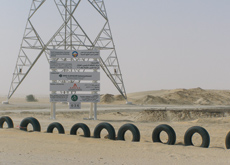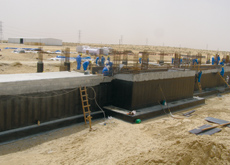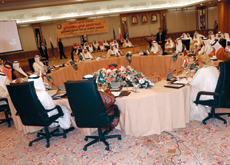
Grid expectations
Jun 2, 2007 - ArabianBusiness.com
|
|
 |
| At this summit in Kuwait in
2004 GCC states agreed to finance the grid project
100%. |
Site of the control centre for
the GCC interconnection grid in Ghunan, Saudi
Arabia. |
One of the Gulf Cooperation Council's objectives
is to promote cooperation in areas of industry and
power. To this end it is working on a power grid that
will connect the systems of its six member states.
The purpose of the grid is to reduce the cost of power
generation for each of the member states and reduce
the levels of generation reserves required. The grid
could improve the quality of power distribution and
ensure a constant supply of electricity at all times,
providing emergency assistance when needed. It is
estimated that the interconnection could save billions
in years to come.
However, it has also become apparent that the grid
could generate revenues of its own, serving as a platform
for energy trading in the region and beyond.
At a recent power and water conference in Abu Dhabi,
Hassan Al-Asaad, head of projects, planning and IT
at the Gulf Cooperation Council Interconnection Authority
(GCCIA), outlined the history of the grid project.
"In 1986 a study was conducted by the Kuwait Institute
for Scientific Research (KISR) and the King Fahd University
of Petroleum and Minerals," he said.
"That was the first study where they deemed it feasible
to pursue the project.
"SNC-Lavalin of Canada, along with Saud Consult and
Hydro-Quebec, were then hired to conduct an economic
and techno-analysis feasibility study for the project
in 1990. That study showed good results."
The GCCIA, head quartered in Dammam, Saudi Arabia,
was subsequently formed by royal decree in 2001. But
there was, of course, an issue of financing. The original
plan was for 35% of the costs to come from equity
- to be paid up front by the states - and 65% to come
from debt through financing from the private sector.
However, following a summit held in May 2004 in Kuwait,
the states agreed they would finance the project 100%,
though how they individually financed it would be
up to them. The overall cost of the project is in
the region of US $1.95 billion.
A contract was awarded to engineering and construction
firm SNC-Lavalin to conduct the prequalification process
on the technical and commercial aspects for all the
tenders. In November 2005, GCCIA then awarded six
EPC contracts for the project: one for substations,
one for the HVDC (high-voltage direct current) conversion,
one for the control centre, two for the transmission
lines and one for a submarine cable.
The tender for the supervision of the project construction
was also awarded to SNC-Lavalin.
Three-phase project
The work required was split up into three phases.
Phase I is currently ongoing and should be completed
by the first quarter of 2009. It involves the interconnection
between Saudi Arabia, Kuwait, Qatar and Bahrain. The
governments of those countries are covering 40%, 36.5%,
13.5% and 10% of the costs of this phase respectively.
Phase II has involved the internal integration of
the independent systems of the UAE and Oman and the
minor interconnection between them. The Dubai and
Abu Dhabi grids were connected in May 2006 and Sharjah
was expected to be connected to these by May 2007.
Phase III will connect the UAE to Saudi Arabia, effectively
connecting phases I and II. Another link between Oman
and the UAE will be added during phase III to enhance
the connection. GCCIA chairman Dr Saleh Al-Awaji recently
said he expected the whole project to be completed
by 2010.
Unique features
Al-Asaad points out that the project is unique because
of its use of a hybrid common neighbour-to-neighbour
interconnection. "This is an independent link, which
would interconnect all the systems and the neighbour-to-neighbour
link between the UAE and Oman," he explains. "GCCIA's
transmission lines will go to each state and there
will be a substation which will act as a node between
each state. That will connect their internal transmission
system with the independent interconnection system.
"It is not a neighbour-to-neighbour link. The states
are all going to be connected to the common backbone,
except for Oman, which is connected to the UAE, which
will be connected to this backbone. The hybrid common
neighbour-to-neighbour interconnection is unique,
not like in Europe where each state is connected neighbour-to-neighbour."
The project will also see the Middle East's first
HVDC station. The 1 800 MW station is required to
convert the frequency between Saudi Arabia's transmission
grid, which operates at 380 kV and 60 Hz to the other
GCC countries, which operate at 400 kV and 50 Hz.
And perhaps the most significant feature of the project
is the use of a submarine cable to connect the island
of Bahrain to Saudi Arabia. The possibility of constructing
a transmission line over the Gulf of Bahrain had been
considered. However, when security and environmental
issues had been examined it was decided that it would
be much more feasible to go with the submerged cable
- albeit at a cost. Installing the submarine cable
represents almost one third of the total cost of the
interconnection project. The in-depth survey of the
rights-of-way of the line has now been completed and
the cable is being manufactured in Europe.
"The link between Bahrain and the rest of the GCC
interconnection grid will be at 400 kV," says Satish
Sud, vice president of transmission and distribution
at SNC-Lavalin. "For environmental reasons it was
decided that the link should be made by means of a
submarine and land cable.
"In Bahrain there are no overhead lines. The 220 kV
grid is made of underground cables. Submarine cables
are expensive to manufacture and have to be protected.
The cable is then brought to the site on special ships.
Given that the water is not deep, there is an additional
requirement to use special barges to lay the cable.
In order to further protect the cable it will be buried
using special techniques."
 . . |
| Work being done on the substation
at Al Fadhili, Saudi Arabia, in April. |
Energy trading
Though the investment is huge, the GCCIA has realised
that the GCC grid system could be used in energy trading,
with regional demand growing at an estimated 8-9%
annually. Trading can be undertaken both among the
GCC states themselves and abroad.
GCCIA is now working with an international legal firm
to develop the interconnection agreements, which set
out how the states would engage in exchanging power,
eventually setting out the principles for future trading
and the rights of using the transmission code. A control
centre is being built that will enable the recording
and billing of energy transactions between the different
countries.
Once the grid is ready, Kuwait and Saudi Arabia will
each receive an extra 1 200 MW of power capacity,
the UAE will receive 900 MW, Qatar 750 MW, Bahrain
600 MW and Oman 450 MW. These represent the amounts
each country can contribute or take.
"The first two purchase orders have been received
already from two GCC member countries, as some countries
expect a shortage in their supply in the short term,
following the establishment of the grid in 2009,"
said Al-Asaad.
GCCIA has forecast that its project will generate
revenues of US $3.2 billion by 2028. But will the
grid recover the investment any time soon? Waleed
Ali Salman, director of electricity at the Federal
Electricity and Water Authority (FEWA), is not convinced.
He thinks the grid could "maybe maintain the tariffs
of electricity consumption" but doubts that it could
generate any revenue of its own.
"Today we have very big tariffs," says Salman. "The
cost of fuel is very high. The cost of manpower, maintenance
- everything is going to increase. As it stands, utilities
will definitely have to increase their prices, otherwise
they will end up with a loss. There is a very, very
small chance of making profit out of it," Since the
GCC shares time zones and peak periods, selling between
the states is not as feasible as it would be to sell
to, and even buy from, other regions in the world,
such as Turkey, North Africa or even Europe.
Pan-Arab project
A prerequisite for power trading with Europe is the
concept of a Pan-Arab grid. This identifies four possible
areas which could be connected: the North African
grid (Morocco, Algeria, Tunisia and Libya), the EJLIS
grid (Egypt, Jordan, Lebanon, Iraq and Syria), the
GCC grid and Yemen, and finally a grid linking Sudan,
Djibouti, Mauritania and the Comoros Islands.
A study looking at linking Egypt and Saudi Arabia
is presently being worked on. Egypt is also being
connected to North Africa and Jordan, while in future
the GCC line could be extended from Kuwait to Iraq.
When asked about the possibility of a Pan-Arab grid,
FEWA's Salman did see more potential. "There may be
some profit with the Pan-Arab grid because there we
will be dealing with different trends," he said. "Today
my peak is in the summertime but maybe in Tunisia
or Morocco that will be different."
The GCC power grid is primarily a good way of saving
on generation costs and dealing with emergencies.
GCC states will be able to supply their surplus power
resources to their neighbours when there are shortages.
The additional capacity eliminates the cost of building
new power plants, along with the issue of identifying
suitable locations at which to build them.
The idea of supplying power to countries on different
continents over vast distances does, however, seem
to be a somewhat far-off prospect and no conclusions
should yet be drawn on how profitable it would be.

|





